#Dwight Eisenhower Presidential Library
Text
What’s that elephant the Danes are wearing?

Tatler’s guide to the emblems and quirks of Denmark’s highest honour, the Order of the Elephant.
A curious little diamond-encrusted elephant, a blue sash, a gold collar – and sometimes a big flaming cape…Tatler looks into the history and tradition of Denmark's most privileged Order.
With Frederik X set to become sovereign of the Order as he becomes King on Sunday, you might see a few of these elephants around Copenhagen's royal palaces
By Isaac Zamet
12 January 2024
When Crown Prince Frederik becomes Frederik X of Denmark on Sunday, he will also replace his mother, Queen Margrethe II, as the sovereign of Denmark’s most ancient and distinguished order of chivalry, the Order of the Elephant.
Though it was officially refounded in 1693, the order dates all the way back to the 1400s, when it was established as a religious confraternity by a group of about fifty Danish knights.
In the 1400s, prior to the Reformation which gripped Europe and divided the church, such religious ‘clubs’ as the Order of the Elephant were common features of aristocratic life.
At the time of the Order of the Elephant's birth, Christian I was King of Denmark – and in fact, Norway and Sweden too, creating a personal union known as the Kalmar Union.
During this period, the emblem of the club was an image of the Virgin Mary holding her Son within a crescent moon.
This was hung from a collar formed of links in the shape of elephants.
The confraternity mutated over the centuries but endured a stifled period after the Reformation in which such clubs became suspect.

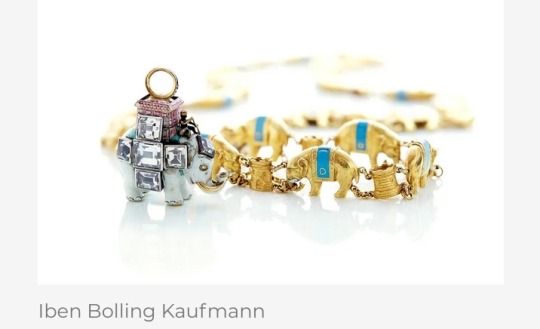
In 1580, Frederik II – eight Frederiks prior to our current Frederik – revived the order and replaced the medallion of the mother and child with an elephant (a Reformation-safe, Protestant approach – if a quirky one!).
But it was Christian V, in 1693, who gave the club its official statues and founding order.
At this time, it was scheduled as comprising 30 noble knights and one Grand Master (the King) along with his sons.
It was only in 1958 that the statutes were amended by Royal Ordinance to allow the ennoblement of women as members of the order.
Between 1580 and today, around 890 persons have been bestowed with the Order of the Elephant; with Queen Margrethe adding 68 people during her 40 year reign.
The recipients are almost always royal persons and foreign heads of state – though in a rare exception, the order was given to a commoner in 2000.


This was the deceased shipping magnate, Mærsk Mc-Kinney Møller, who was recognised for exceptional contribution to Danish economic strength and Danish society.
Those unfamiliar with the man himself will surely recognise his name from the famous shipping containers.
The A.P. Møller – Mærsk group was actually founded in 1904 by his father. It is now worth $81bn dollars.
At the time of Møller’s membership of the order, he was the only non-royal and non-head of state to hold the honour; though it had previously been held by the pioneering nuclear physicist, Niels Bohr.
Membership of the order comes with possession of its rather eye-catching elephantine emblem.
The elephant is made of white-enamelled gold with blue housings and is about 5cm high.

On its back, the elephant bears a tower of pink enamelled masonry (a design originally intended to reflect the howdah compartments of the Indian subcontinent).
A number of large cut diamonds adorn the elephant, along with a crowned monogram of the monarch reigning when it was made.
One wonders, then, when the first Frederikian elephants will be carved.
At the top of the tower on the elephant’s back sits a gold ring, from which the badge can be hung from the collar or tied to a sash.
On the elephant's back sits a turbaned ‘moor mahout.’
It should be noted that some would regard such a depiction as an exoticising caricature.
Others would regard its appearance merely as an expression of an historical perspective.

One striking detail about the circulation of the elephants is that each Order of the Elephant is – in principle – on loan and must be returned to the Chapter of the Royal Orders of Chivalry when a member of the Order has passed away.
This rather quaint custom means that elephants are inherited and used several times by different members of the order, with some dating back hundreds of years.
Interestingly, the done thing is not to disclose to whom an Elephant has previously been given – though there are some traditional lines of inheritance.
For example, the elephant recently bestowed on Prince Christian belonged previously to his grandfather, Prince Henrik.
This handing over was always to be, on the basis of a traditional line of inheritance.
There are two exceptional elephants which have eluded the rule of the ‘loan’ – one remains in the Chancellery Museum at Paris and a second remains on display at the Dwight Eisenhower Presidential Library in the US.
Another beautiful quirk of membership of the Order is that a member’s coat of arms is always painted and subsequently hung in the Knight’s Chapel at Frederiksborg Castle in Hillerød.
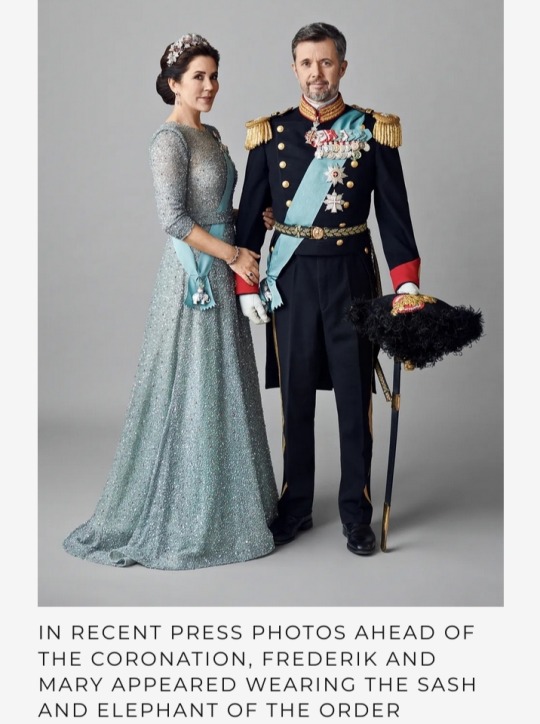
As to when the elephants come out to play, there are some rather interesting traditions concerning how and when to wear them.
The Order of the Elephant has three festival days: new year’s day, the monarch’s birthday, and the birthday of Valdemar the Victorious, which, if you didn’t know is on June 28.
On these festival days, the Order of the Elephant is worn on the chest on a gold chain link collar, with links shaped as towers and elephants.
The collar sits on each shoulder. On other important occasions, the order is worn on a bright blue sash with a breast star.
The star of the order is an eight-pointed silver star with smooth rays; at its centre sits an enameled red disc with a white cross, surrounded by a laurel wreath in silver.
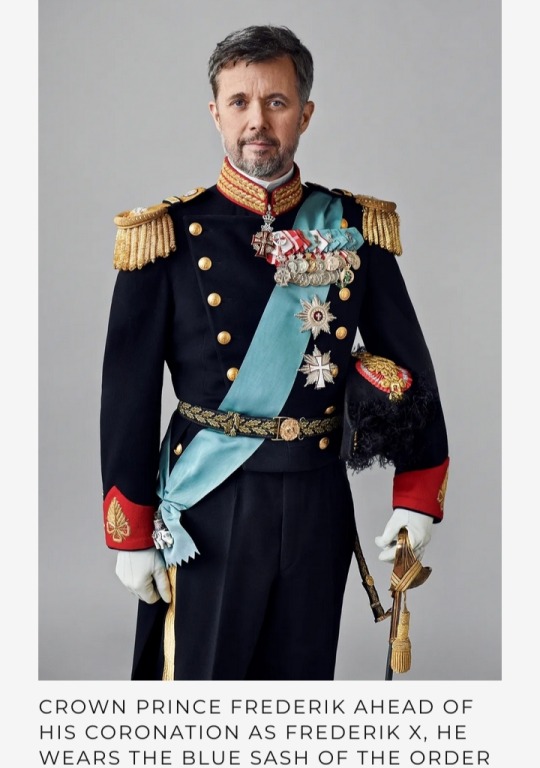
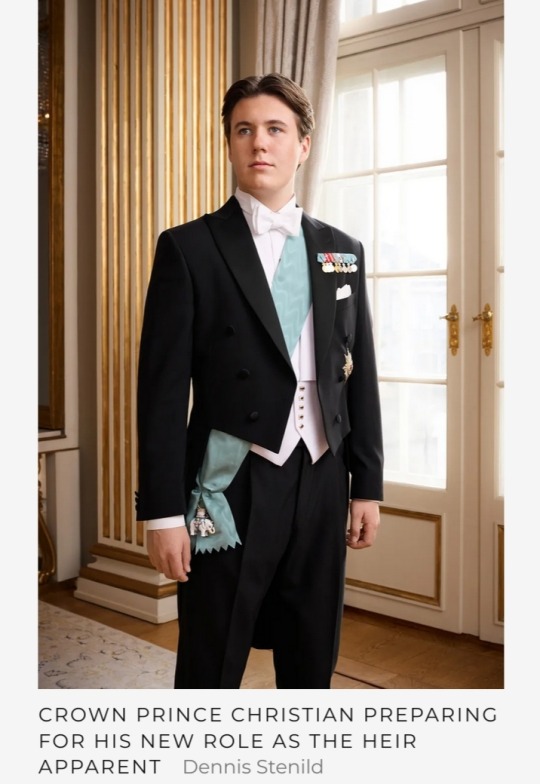
#Frederik X#Queen Margrethe II#Monarchy of Denmark#Danish Royal Family#House of Glücksburg#Christian I#Kalmar Union#Order of the Elephant#Frederik II#Christian V#Mærsk Mc-Kinney Møller#Frederikian elephants#Chancellery Museum#Dwight Eisenhower Presidential Library#Knight’s Chapel#Frederiksborg Castle#Crown Prince Christian of Denmark#Queen Mary of Denmark
31 notes
·
View notes
Text
Through Mamie's Eyes
Recently I visited the Dwight D. Eisenhower Presidential Library, Museum and Boyhood Home. Curator William Snyder provided us with a tour. I loved learning the Eisenhower story through Mamie’s eyes.
William Snyder curator of the museum provided our tour.
We saw the boyhood house where President Eisenhower grew up, then we toured the library and museum, plus, we viewed the memorial where he and…
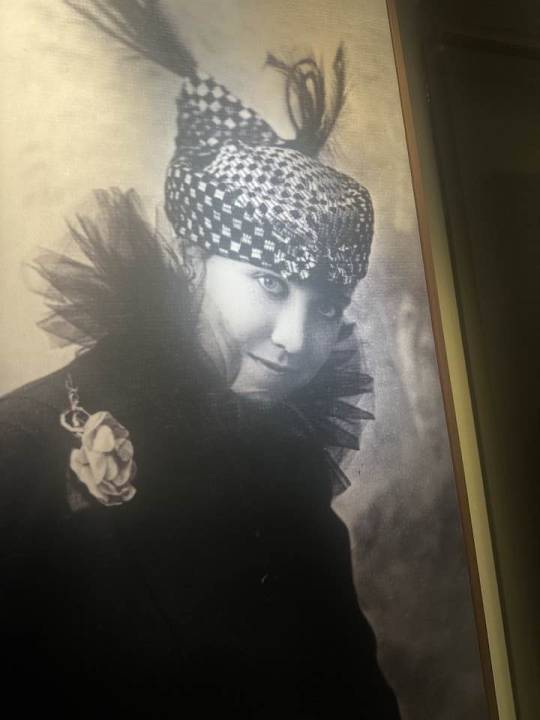
View On WordPress
#"Icky" Eisenhower#34th President of the United States#Abilene#Atomic Energy Agency#Belle Springs Creamery#Blackhawk Cocshutt tractor#campaign#Cold War#Colorado#Columbia University#cowboy trail#curator#Denver#Doud Eisenhower#Dwight D. Eisenhowere Presidential Library Museum and Boyhood Home#Eda Mae Doud#Eisenhower#Eisenhower trail#Eleanor Carlson Doud#Elivera Mathilda Carlson#Gettysburg#highway system#Ida Eisenhower#inaguration#John Sheldon Doud#Kansas boy#Mamie bangs#Mamie Eisenhower#memoiral#military journey
0 notes
Text
A Culinary Journey Through Presidential History 🥪🍰🍽
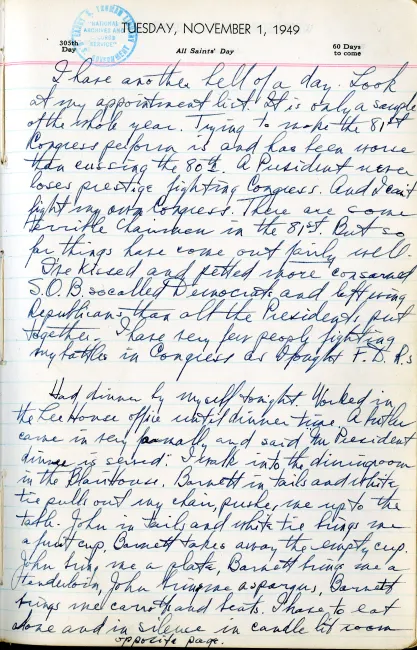
Delving into the culinary history of the White House is a fascinating exploration of taste and tradition. This article embarks on a delicious journey through time, highlighting five remarkable recipes from the kitchens of past U.S. Presidents and First Ladies. These recipes not only offer a taste of history but also reflect the diverse palates and influences that have graced the Presidential table.
Bess Truman's Bing Cherry Mold
Bess Truman, known for her skill and style in the kitchen, contributed a variety of recipes that satisfied many. Among these, the Bing Cherry Mold stands out. This dessert, a perfect blend of sweetness and texture, reflects the simplicity and elegance of the Truman era. Truman had specific dietary preferences, famously disliking onions, and maintaining a healthy diet, but this dessert was a family favorite, indicating a balance between health and indulgence.
Rosalynn Carter's Plains Cheese Ring
Rosalynn Carter's Plains Cheese Ring is a savory delight that hails from the Southern culinary tradition. This cheese appetizer, named after the Carter's hometown in Georgia, is a testament to Rosalynn's commitment to bringing a touch of home to the White House. Its rich, creamy texture paired with the tang of sharp cheddar and the sweetness of strawberry preserves, offers a unique and memorable flavor experience.
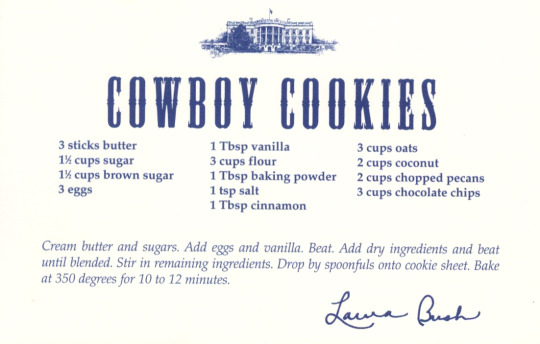
Laura Bush's Cowboy Cookies
First Lady Laura Bush’s Cowboy Cookies are a testament to her Texas roots. These chunky, flavorful cookies, packed with oats, nuts, coconut, and chocolate chips, offer a hearty taste of the American Southwest. They were notably a part of her husband's Presidential campaign, symbolizing warmth and hospitality.
Dwight D. Eisenhower's Apple Pie

President Eisenhower was not only a leader but also an enthusiastic cook, particularly known for his apple pie. His version of this classic American dessert is said to be a delightful mix of sweetness and spice encased in a perfectly flaky crust. This pie represents Eisenhower's love for simple, home-cooked meals, a contrast to his high-profile public life.
Gerald Ford's Red Flannel Hash
Gerald Ford's Red Flannel Hash is a colorful, comforting dish that combines cooked beets, potatoes, and corned beef. This dish, with its vibrant red hue and hearty ingredients, is a nod to Ford's Midwestern roots and a symbol of the simple, wholesome American fare.
www.fordlibrarymuseum.gov/library/document/0126/1489765.pdf
Exploring these recipes is not just about the flavors and ingredients; it's a journey through the different eras of American history, each dish telling a story of the time and the people in the White House. From the elegance of Bess Truman's desserts to the rustic charm of Laura Bush's Cowboy Cookies, these recipes offer a delectable glimpse into the nation's past, one plate at a time.
Read more:
167 notes
·
View notes
Text
Vivek Ramaswamy and other Republicans are trying to rehabilitate the memory of Richard Nixon. I will concede that Nixon is at least a step up from Donald Trump; Nixon wrote his own books and probably even read them.
In the current GOP, Dwight Eisenhower and Gerald Ford are nonpersons; the integrity and honesty of Ike and Jerry are too high a standard for today's cesspool-dwelling Republicans.
Current Republicans are Reaganites In Name Only. If he somehow returned, Uncle Ronnie would castigate the Kremlin-friendly Trumpsters who play footsie with the Evil Empire which is now led by a onetime KGB (secret police) colonel.
The Bush clan has never been on great terms with the Trump crew. Jeb's kid, George P. Bush, had tried to save his own political skin by pandering to MAGA – but to no avail.
So Richard "Tricky Dick" Nixon enters into the revisionist GOP pantheon.
In late August, Republican presidential hopeful Vivek Ramaswamy took a break from his typical campaign events to make a pit stop at an unusual venue for mainstream Republicans: The Richard Nixon Presidential Library. Speaking before a packed house, Ramaswamy was slated to deliver a speech on foreign policy. But his opening remarks served the more provocative purpose of challenging Nixon’s much-maligned status in the annals of conservative history.
“He is by and away the most underappreciated president of our modern history in this country — probably in all of American history,” said Ramaswamy, without a hint of irony.
Ramaswamy’s homage to America’s most disgraced ex-president perplexed some liberal commentators, for whom Nixon remains the ultimate symbol of conservative criminality. But Ramaswamy is far from alone in rethinking Nixon’s divisive legacy. Among a small but influential group of young conservative activists and intellectuals, “Tricky Dick” is making a quiet — but notable — comeback. Long condemned by both Democrats and Republicans as the “ crook” that he infamously swore not to be, Nixon is reemerging in some conservative circles as a paragon of populist power, a noble warrior who was unjustly consigned to the black list of American history.
Across the right-of-center media sphere, examples of Nixonmania abound. Online, popular conservative activists are studying the history of Nixon’s presidency as a “ blueprint for counter-revolution” in the 21st century. In the pages of small conservative magazines, readers can meet the “ New Nixonians” who are studying up on Nixon’s foreign policy prowess. On TikTok, users can scroll through meme-ified homages to Nixon. And in the weirdest (and most irony laden) corners of the internet, Nixon stans are even swooning over the former president’s swarthy good looks.
I can understand them loving Nixon for his attempts to improve ties with Putin's old Soviet Union. But Nixon as a sex symbol requires a strong imagination. He's hot only when compared to Donald Trump or Rudy Giuliani.
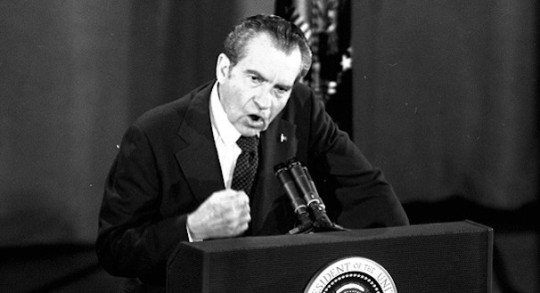
“No man is perfect — Richard Nixon definitely wasn’t — but one element of his legacy that I respect is reviving realism in our foreign policy,” said Ramaswamy in an interview from the campaign trail, pointing specifically to Nixon’s successful efforts to reestablish diplomatic relations with China during the 1970s. “Pulling Mao out of the hands of the USSR was one of the great victories that allowed us to come to the end of the Cold War … and it took an independent thinker like Nixon to lead us out of that.”
What Ramaswamy ignores is that Nixon escalated the Vietnam War after promising "peace with honor" in his 1968 campaign. After Nixon invaded Cambodia in 1970, large protests broke out across the US which led to the killings of unarmed students by National Guard troops at Kent State University in Ohio and Jackson State University in Mississippi.
And Nixon certainly did not pull "Mao out of the hands of the USSR" the way Vivek claimed. The China-Soviet split pre-dates the Nixon administration by over a decade. The USSR and China even fought a small border war against each other in 1969.
youtube
Ramaswamy has a pitiful understanding of the world. Like Elon Musk, most of his knowledge of geopolitical history seems to come from memes and dubious social media posts. Tech billionaires are among the most ignorant people on the planet outside of their narrow fields.
#richard nixon#vivek ramaswamy#republicans#republicans think nixon is hot#springtime for nixon#the vietnam war#china#geopolitics#cold war history#tech billionaires#election 2024
11 notes
·
View notes
Photo

Le Capitaine Dwight D. Eisenhower ( à droite) avec trois amis (William Stuhler, le Major Sereno Elmer Brett et Paul V. Robinson) en 1919, quatre ans après avoir obtenu son diplôme de West Point
©Dwight D. Eisenhower Presidential Library and Museum
#Avant-guerre#Pre-war#Les femmes et les hommes de la guerre#Women and men of war#Personnages militaires#Figures militaires#Military figure#Personnages historiques#Historical figures#Dwight D. Eisenhower#Sereno Elmer Brett#1919
27 notes
·
View notes
Note
what is the best way to find the full transcripts of speeches by presidents? is there a site that you use for that sort of research?
Yes, there are two particular sites that I tend to use whenever I'm researching speeches or Presidential messages and they are both excellent sources.
The American Presidency Project at the University of California, Santa Barbara is an invaluable resource. The UCSB site has archived hundreds of thousands of speeches, press conference transcripts, messages, and declarations from every President in American history. It's amazing how much information they have available for researchers, and how easy they've made it to navigate the site and find specific speeches or documents. As an example, f you felt like finding the transcripts for the 200+ press conferences that Herbert Hoover did while he was in office, UCSB's American President Project has them ready for your reading pleasure. And they don't just provide easy access to the major speeches that Presidents made while in the White House. You can find transcripts of quick remarks that Presidents made from train platforms during whistle-stop campaigns or radio addresses or signing statements. It's really an indispensable resource for researchers of the Presidency.
The Miller Center at the University of Virginia also has an incredibly useful website with archives of Presidential speeches, but also in-depth essays and features about the Presidency and each of the Presidents. There are extensive oral histories on Presidents dating back to Jimmy Carter, with fascinating insight from scores of people. And the Miller Center has also created a site within their website focusing on the tapes from the White House recording system that eventually helped bring down Richard Nixon. Nixon wasn't the only President who secretly recorded conversations in the White House, and there are tapes available from Franklin D. Roosevelt, Harry Truman, Dwight Eisenhower, John F. Kennedy, and Lyndon B. Johnson, as well as Nixon. Instead of having to search for those recordings at each of those Presidents' respective Presidential Libraries, the Miller Center has made it possible to search their archives for all of those Presidential Recordings. In most cases, they've also helpfully provided transcripts as the tapes are frequently difficult to clearly understand.
Those two sites are pretty much perfect for Presidential history researchers, particularly if you're seeking transcripts of speeches or Presidential messages. I'd also strongly recommend checking out the Presidential Library websites if you're researching someone who has a library. In my opinion, the Presidential Library system is one of the treasures of the National Archives and a treasury of research potential. Almost all of the 15 Presidential Libraries in the network officially maintained and operated by the NARA have extensive research materials that can be accessed online.
#Presidential History#Presidential Speeches#Presidential Research#History#Research#Presidential Studies#American Presidency Project#University of California Santa Barbara#UCSB#Miller Center at the University of Virginia#Miller Center#University of Virginia#Presidency#Presidential Libaries#Presidential Library System#National Archives#National Archives and Records Administration#NARA#White House Tapes#Presidential Recordings
46 notes
·
View notes
Text
“Does anybody see a V.P. in that group? I don’t think so,” joked Donald Trump as he was speaking in Michigan before the Republican presidential debate. As far as Trump and many others are concerned, the contest for the Republican presidential nomination is already over and he can dismiss the entire GOP field as political nobodies. As his seven remaining Republican challengers gathered at the Ronald Reagan Library in Simi, California, Trump was near Detroit addressing auto workers in a non-union plant just one day after President Biden appeared on a picket line near Bellville, Michigan with unionized autoworkers, all members of the United Auto Workers (UAW). Inveighing against President Biden’s electric vehicle mandate, he proclaimed that in a Trump administration, gas vehicles will be allowed and sex change operations for minors will be banned.
It’s not hard to understand why the president and the former president made back-to-back appearances in Michigan. In 2016, Trump won Michigan by 11,000 votes on his way to a shocking upset victory over Hillary Clinton. In 2020, Biden took back the state by 154,000 votes, and union workers made a big difference. Biden got 62% of their vote in 2020, compared to just 53% for Clinton four years earlier.
The struggle between Democrats and Republicans over the working-class vote is a story that stretches back more than half a century. From the New Deal through the mid-1960s, these Americans formed the heart of the Democratic coalition, whose string of victories was interrupted only by a war hero, Dwight Eisenhower, who was courted by both parties. But after Lyndon B. Johnson’s landslide victory in 1964, discord over the Vietnam War, race, and the counterculture began to divide college educated and non-college Democrats. Unlike more upscale Democrats, white working-class voters supported the war, opposed the counterculture, and opposed racial integration when it seemed to threaten their neighborhoods, schools, and jobs.
Republicans exploited these divisions with robust appeals to patriotism and “traditional values” and by opposing affirmative action in hiring. After Ronald Reagan’s landslide victory over Walter Mondale in 1984, Democrats could no longer ignore their waning appeal to the white working class. In a study commissioned by the Michigan Democratic Party and financed primarily by the UAW, Stanley Greenberg, a public opinion expert and political analyst questioned focus groups in Macomb County, a working-class suburb of Detroit where Democratic voters had shifted extensively to the Republican column.
Greenberg’s findings triggered an intense debate among Democrats and led to efforts to elevate economic interests shared by white and Black voters over race-specific appeals. Bill Clinton rode this new strategy to victory over incumbent president George H. W. Bush in 1992 and an 8-point reelection victory in 1996, recovering a significant share of white working-class voters from the Republicans while retaining supermajorities of Black Americans.
For the next two decades, Republican candidates competed for white working-class voters predominantly with cultural appeals while retaining a pro-business economic agenda focused on tax and spending cuts—including reduced outlays for Social Security and Medicare. For their part, Democrats focused on economics, defending the large entitlement programs and charging that the Republicans’ plans for taxing and spending favored wealthy individuals and big business.
Trump’s insurgent 2016 campaign brushed aside the Reagan-Bush conservatism on his populist-style march to the Republican nomination. Trump claimed to be the only true defender of working-class interests and values, denouncing globalization, “unfair” trade deals, and China’s rise, which he argued had come at the expense of American workers. In the famous “down the escalator” speech announcing his candidacy, he insisted that Social Security, Medicare, and Medicaid needed to be saved without any cuts to beneficiaries. As president, Trump worked to retain his position as the working-class champion by drawing back from international economic institutions, pursuing a more protectionist strategy on trade, and denouncing Chinese exports as an assault on American workers. Democrats were thrown on the defensive, backing away from policies such as the Trans-Pacific Partnership that President Obama had advocated for.
The nomination of Joe Biden, who had long styled himself as the defender of the working class and of organized labor, represented the Democrats’ recognition of the changed landscape. Biden deemphasized trade treaties, pushed for “Buy American” policies in federal programs, and embraced an industrial strategy designed, as he often stated, to “create millions of high-paying union jobs right here in the USA.” This shift undergirded the increased working-class support that helped him accomplish in 2020 what Hillary Clinton could not in 2016.
This history set the stage for the clash between Biden and Trump in Michigan this week. More than a year before the general election, Trump and Biden have begun their campaign, with Biden aligning himself with the UAW leader’s attack on “corporate greed” and Trump proclaiming that Biden’s electric vehicle (EV) mandate would destroy autoworkers’ jobs and “assassinate” the U.S. automotive industry. EVs, Trump proclaimed, don’t travel far enough, cost too much, and are mostly made in China. He told the autoworkers that Biden is selling them out to the “radical environmentalists” and that their negotiations with the Big 3 automakers were meaningless if their leadership didn’t oppose the EV mandate. If the mandate persists, he predicted, their jobs will disappear and all the EVs will be made in China.
Rather than imposing mandates and regulations on our domestic auto production, Trump ticked off the accomplishments on trade during his presidency and promised what he termed “patriotic protectionism”—a new 10% across-the-board tariff—and what he termed “reciprocal tariffs” to match the barriers imposed by other countries. He offered a vision of American-made cars running on fossil fuels produced in America, a future in which American manufacturing is restored to what it was decades ago, where the gleaming factories and humming assembly lines are in the U.S. and the rusting factories are overseas.
While Trump was starting the general election, seven Republicans were on stage in California fighting for the Republican nomination. They didn’t seem to know that the race was over. Trump leads the Republican field in every poll, pulling off the amazing feat of increasing his lead even as an unprecedented number of indictments rolled in and his reputation as a brilliant businessman and his business itself was destroyed by a judge in New York.
So, what were those seven Republicans doing onstage?
Hoping for lightning to strike. If you read today’s polls, their collective stance sounds ridiculous, but the history of nomination races says not so fast. In a nomination race, one of the most dangerous positions to be in is “front-runner.” That’s because in the early stage of the nomination race, before many delegates are actually awarded, “winning” is defined by “winning” the expectations game and front-runners can run afoul of “expectations.”
A bit of history shows what could happen. In 1984, former Vice President Walter Mondale was running for the Democratic nomination. He was considered by most to be the front-runner and in the first contest, the Iowa caucuses, he garnered a substantial vote. It was so big, in fact, that the next day, the New York Times declared, “The magnitude of Mr. Mondale’s lead, however, also underscored predictions that no one would be able to stop him if he won a majority or near- majority victory over a crowded field.”
But what happened next is a warning to front-runners everywhere in every decade. The second-place candidate was a young, largely unknown U.S. Senator from Colorado, Gary Hart. He had no organization, no money, and no national name recognition save having been George McGovern’s campaign manager 12 years earlier. And yet it was Hart, not Mondale, who came out of Iowa like a shot and won the New Hampshire primary eight days later on the strength of momentum alone. And while he didn’t end up winning the nomination, he gave Mondale a run for his money all the way to the last primary.
So, what were all those candidates doing on stage? Trying to be Gary Hart or, in other words, trying to be the number two candidate who can go one-on-one with Trump. Nationally, Trump runs about 42 points ahead of the rest of the field, but in New Hampshire, he runs about 31% ahead of the rest of the field. In the early states, the voters are beginning to be engaged and tell pollsters they are open to alternatives.
The second Republican debate showed some signs of a nomination race that is maturing. The first sign is that they have figured out how to criticize Trump. With one solitary exception, it became clear that no one was going to touch Trump’s many indictments and the day’s ruling on fraud in his business empire with a 10-foot pole. However, they did criticize Trump’s record. The lead critic, former New Jersey Governor Chris Christie, said, “Trump, you’re afraid of being on this stage tonight, not because of the polls, not because of the indictments, but because you can’t defend your record.” Florida Governor Ron DeSantis accused Biden of being missing in action on the shutdown talks and then added, “You know who else is? Donald Trump. He should be here tonight.” And former South Carolina governor Nikki Haley accused Trump of being wrong on China, reciting a long list of policies that Trump did not focus on.
But with Trump not being present, they spent the bulk of their airtime attacking each other. It was clear that Haley wanted to send Vivek Ramaswamy to the corner—continually interrupting him and criticizing him for his dealings with China and TikTok. Senator Tim Scott (and former Vice President Mike Pence) rolled out some opposition research on Vivek Ramaswamy supposedly making money from business dealings in China. Pence attacked DeSantis for his spending in Florida, Haley attacked DeSantis for his energy policies and Scott for his lack of executive experience.
The two people who no one attacked were the Governor of North Dakota, Doug Burgum, and former Vice President Pence. Burgum kept trying to convince the audience that his experience as a business leader was key, but on the same day Trump was unveiled as more con artist than business leader, it was probably not the best time for that argument. Pence kept talking about his experience for the office, taking both of us back to 1984 when we worked for former Vice President Mondale. It didn’t work so well then, and it probably won’t work so well today. If no one criticizes you, it may be because they don’t think you’re a threat.
Debates don’t correlate exactly to votes, but they do give the voter a sense of how the candidates make their case. And, as the second Republican debate made clear, the battle for second place is on. We don’t know yet who may emerge as the alternative to Trump, although Haley is making a strong bid for that scenario. But last night’s debate showed that the GOP field understands that, for the time being, their real enemy is not Trump but one another, and the task over the next few months will be deciding who confronts Trump if the race becomes a one-on-one match against the former president. Whether that battle will center on Trump’s indictments, experience, or governing record will decide if there is a “Gary Hart” in this field or if Trump will romp untouched to the GOP nomination.
2 notes
·
View notes
Text
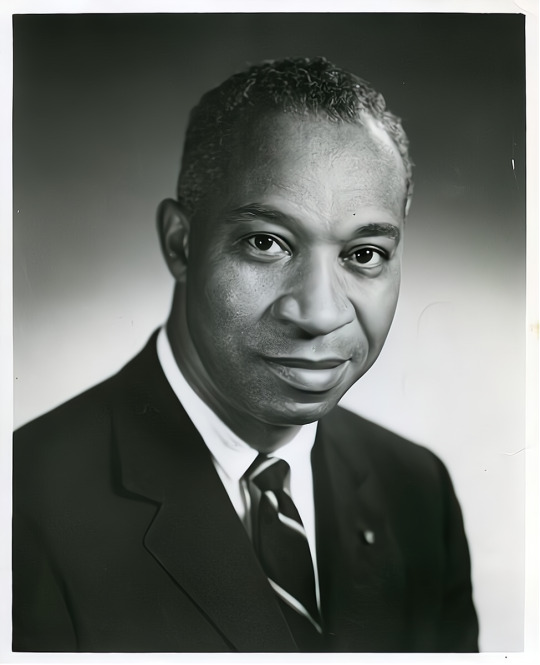
Major Everett Frederic Morrow (April 20, 1909 - July 19, 1994) the son of John Eugene Morrow, a library custodian who became an ordained Methodist minister, and Mary Ann Hayes, a former farm worker and maid, was born in Hackensack, New Jersey. He graduated from Hackensack High School in 1925, where he served on the debate team for three years and was their president his senior year.
He attended Bowdoin College and at the time was one of only two African American students enrolled there. He did well academically but was forced to withdraw his senior year to help his family. He worked as a bank messenger on Wall Street and secured a social work job. He joined the National Urban League as a business manager of Opportunity Magazine, and he became a field secretary for the NAACP, traveling across the nation to promote membership and fundraising.
He entered the Army as a private and was promoted to sergeant within a month. He graduated from Officers Candidate School and was discharged as a Major of Artillery.
He graduated from Rutgers Law School with a JD. He returned to active duty in the armed forces during the Korean War. He joined the CBS as a public affairs writer.
General Dwight Eisenhower’s Presidential campaign hired him as a personal adviser and administrative assistant. He was appointed advisor on Business affairs in the Department of Commerce. He became the first African American Presidential aide in history, serving as Administrative Officer for Special projects on President Eisenhower’s staff (1955-61).
He was frustrated and angered that many qualified African Americans were excluded from high-level political positions in government and the private sector. His executive position in the White House was an important symbol of racial progress.
He became Vice President of the African-American Institute in New York. He was the first African American at Bank of America to be promoted to Vice President of its New York-based international subsidiary. He was an executive for the Education Testing Service. He was a member of Sigma Pi Phi and Alpha Phi Alpha Fraternities. #africanhistory365 #africanexcellence #alphaphialpha #sigmapiphi
0 notes
Text
What's wrong with Balloons?
So, as we may or may not be aware; China had sent a balloon into U.S. airspace, and it was shot down on Saturday February 4th, 2023 by the U.S.. The Biden Administration suspects that this balloon was actually a spy balloon; much like the spy balloons sent by the U.S. over China and the Soviet Union back in 1956. But we (the U.S.) called them ‘weather balloons’ so it was okay, right? I mean, we were doing so “in defense,” in case either one of those countries decided to pull a surprise attack on us while we were in the Vietnam War.
It’s also extremely understandable that the U.S. government would be suspicious about the purpose of these balloons too; according to The Intercept “America sent spy balloons exactly the same size over both the Soviet Union and China in 1956 — and made exactly the same claims as China is making today about what we were up to.”
While the US balloons were about 20 stories tall, or around 200 feet, reports indicated that the Chinese balloon is also believed to have been up to 200 feet tall. So, there’s a lot of similarities between these balloons; or at least that’s what they’re telling us. It could be exaggerated though; who knows?
Also, the president of the U.S. at the time was Dwight D. “Ike” Eisenhower, who was part of the Republican party; for those of us who didn’t know that. He was also a Jehovah's Witness; which I just found pretty interesting.
At a news conference on February 7, 1956, Eisenhower's Secretary of State, John Foster Dulles, engaged in a lengthy, hilarious prevarication about the spy balloons. First, there was outright deception. “The information that is being sought,” he said, “is not essentially or even at all military information.”
The question here is, what was the US goal with all these balloons? “They are gathering an extraordinary amount of new and useful information about these jet stream air currents. … [it] is a part of a project which has worldwide significance.”
I bring this up because the archivist of the Eisenhower Presidential Library, David Haight, produced a 2009 article titled “Ike and His Spies in the Sky.” In it, he writes, based on records of White House deliberations, “Eisenhower authorized aerial intelligence collecting programs in order to better assess the military capability of the Soviet Union, China, and other Communist bloc nations to launch a surprise attack on the United States.” In other words, the U.S. saw its balloon and U-2 programs as being essentially defensive. So, I think it’s very much plausible that China could be thinking in a similar way, if their balloon was in fact, collecting information. Because if the U.S. did it, then why can't they do it?
In any event, it's unclear what can be learned from the current balloon mania. However, other people think that a balloon revolution is just around the corner and that this is what some believe could be the beginning of a "balloon war."
I'd love to hear your opinions on this!! Feel free to reblog, comment; whatever! Have a great day.
#current events#current events 2023#china#united states news#balloons#spy balloon#spying#countries#news
0 notes
Text
Top 10 World Famous Living Architects

In this article, we shall explore the famous architects that are behind the world-famous buildings. Their talent and unique mindset made their work creative and mindblowing. The fact that they are out there creating many more projects is admirable. The legacy these architects hold will forever be here and the extraordinary buildings they’ve created will be the proof of it.
1. Frank Gehry
Amazingly, one of the most well-known architects in the world, Frank Gehry, first became well-known for creating his own home
One of the earliest examples of deconstructive architecture is said to be The Gehry Residence in Santa Monica, California
Gehry’s house has long been a source of admiration because it was constructed from such unusual elements as corrugated steel and chain-link fencing
Since then, among Gehry’s several well-known creations include the Cinematheque Francaise in Paris, France, the Walt Disney Concert Hall in downtown Los Angeles, the titanium-clad Guggenheim Museum in Bilbao, Spain (shown), the New World Center in Miami Beach, Florida, and many others
Gehry is currently the National Dwight D. Eisenhower Memorial’s designer
2. I.M. Pei
I.M. Pei, who was born in China, is without a doubt one of the most incredible and well-known architects on the entire globe
The John F. Kennedy Presidential Library in Dorchester, Massachusetts, the west wing of the Museum of Fine Arts in Boston, the Fragrant Hill Hotel in China, the Mile High Center in Denver, Colorado, the Rock and Roll Hall of Fame in Cleveland, Ohio, and the glass pyramid at the Louvre in Paris, are just a few examples of his classic and thought-provoking designs
For his contributions to the realm of architecture, Pei received the Pritzker Architecture Prize in 1983
Even though Pei stopped working as an architect on a full-time basis in 1990, he now consults for his sons’ firm, Pei Partnership Architects
3. Zaha Hadid
The world’s most well-known female architect, Zaha Hadid, has established herself as a fantastic role model for women in the traditionally male-dominated profession of architecture
Hadid, an Iraqi-born architect who studied at the American University of Beirut in Lebanon and the School of Architecture in London, is known for designing well-known structures like Glasgow’s Riverside Museum, the Guangzhou Opera House, and the aquatics center for the London Olympics
Hadid won the Pritzker Architecture Prize for a pavilion in Zaragoza, Spain, in 2004, becoming the first female architect to do so
4. Renzo Piano
Italian architect Renzo Piano is best known for his work on museums; he also designed the New York Times Building in Manhattan, the California Academy of Sciences in San Francisco, the NEMO science museum in Amsterdam, the Auditorium Parc della Musica in Rome, and The Shard in London, which is currently the tallest skyscraper in the European Union
And The Centre Georges Pompidou in Paris is perhaps Piano’s most notable design, for which the New York Times claimed that he had “turned the architecture world upside down
5. Jean Nouvel
French architect Jean Nouvel is known for creating some of the most popular and well-known structures on the entire globe
The expansion of the Reina Sofia Museum in Madrid, Spain; the Guthrie Theater in Minneapolis, Minnesota; the Copenhagen Concert Hall in Denmark; the Doha Tower skyscraper in Qatar
Nouvel won the 2008 Pritzker Architecture Prize for the Torre Agbar skyscraper in Barcelona
Nouvel is a founding member of Syndicat de l’Architecture, the top French union for architects
Several projects, notably the new Abu Dhabi location of the Louvre Museum, are currently being worked on by Nouvel
6. Sir David Chipperfield
It’s no surprise that Sir David Chipperfield is one of the most incredible architects in the world with work in more than 20 nations across four continents
Chipperfield, a British architect with offices also in Berlin, Milan, and Shanghai, is primarily responsible for the design of a number of museums, hotels, and governmental structures, including the Museum of Modern Literature in Marbach, Germany, the Valentino New York Flagship store, America’s Cup Building in Valencia, Spain, the Neues Museum in Berlin, the Liangzhu Culture Museum in China, and numerous others
More impressively, Chipperfield’s works have won over 100 awards in the fields of architecture and design, including the esteemed RIBA Stirling Prize (2007), the European Union Prize for Contemporary Architecture (2011), and the Deutscher Architekturpreis (2011)
7. Santiago Calatrava
Spanish architect Santiago Calatrava, who is renowned for his distinctive neo-futuristic design, has completed approximately 100 structures over more than three decades
Though bridges and train stations made up the bulk of his early work, he is also well known for a wide range of theatres, hotels, sports arenas, and museums
The Athens Olympic Sports Complex in Athens, Greece; the Liege-Guillemins railway station in Liege, Belgium; the Museum of Tomorrow in Rio de Janeiro, Brazil; the Chords Bridge at the entrance to Jerusalem in Israel; the Alamillo bridge in Sevilla, Spain; the Athens Olympic Sports Complex in Athens, Greece; the Alamillo bridge in Sevilla, Spain;
Numerous honours have been given to Calatrava’s work, such as the Auguste Perret Prize, the AIA Gold Medal, and the European Prize for Architecture
8. Moshe Safdie
Moshe Safdie, an architect, urban planner, educator, thinker, and author who was born in Israel but has lived most of his life in Canada, has long been regarded as a major force in the field of architecture
Dramatic curves, geometric patterns, and generous use of windows and greenery are all distinctive elements of Safdie’s architectural design
Over the course of his career, he has created more than 40 structures, some of the most amazing of which include the Skirball Cultural Center in Los Angeles, the National Gallery of Canada in Ottawa, the Yad Vashern Holocaust History Museum in Jerusalem, the Asian University for Women in Bangladesh, and Habitat 67 in Quebec, Canada
9. Peter Zumthor
Swiss architect Peter Zumthor is well-known and esteemed for his uncluttered creations
Despite running a relatively tiny business in Haldenstein, Switzerland, Zumthor has built up a rather amazing portfolio that includes, among other things, the Serpentine Gallery Pavilion in London, the Cloud Rock Wilderness Lodge in Moab, Utah, and Therme Vals in Graubunden, Switzerland
Over sixteen important prizes have been given to Zumthor’s work in the past three decades, with the Thomas Jefferson Foundation Medal in Architecture (2006), the Pritzker Prize (2009), and the RIBA Royal Gold Medal among the most notable (2013)
10. Tom Wright
Tom Wright is one of the top ten most incredible architects, despite the fact that he only has one significant piece of work to his name
Wright, who is based in London, has spent the majority of his career leading Atkins, a global engineering, design, planning, and architectural design firm
Wright was appointed design director for the Jumeirah Beach Resort in Dubai in 1993
For this project, he created the distinctive Burj Al Arab (Tower of the Arabs), which is today among the most recognizable structures in the world
The Burj Al Arab, which was constructed to resemble the sail of a dhow (a traditional Arabic ship), is meant to honour both Dubai’s maritime history and its forward-thinking modernization
REFERENCE:
https://www.bestliberalartscolleges.org/10-amazing-architects-alive-today/
DISCLOSURE:
None of these articles constitutes financial advice. Articles are highly summarised to make it easy for the reader and save your time, so please DYOR further before putting your hard-earned money into any product mentioned.
Please note that the tech industry evolves rapidly and the info in this article is correct at the time of publishing. As Heraclitus said, “Change is the only constant,” so if anything sounds old or off, please holler on the socials or comment here so everyone stays peeled.
Affiliate links may be included in these articles, and signups through these links are highly appreciated. These links support better research and quality writing and help you find the right products with less hassle, so it’s a win-win :) Great care is taken to ensure the links are from authentic, non-spammy sources.
Stay up-to-date on the latest stories by signing up for the newsletter. Please don’t mark these emails as spam, instead, you can easily unsubscribe.
0 notes
Text
I Like Kansas
Recently I had the chance to visit the Midwestern state of Kansas. Located in the heart of the United States, Kansas is sometimes considered flyover country for many tourists – those places you see from the airplane while you travel between the metropolises of the West and East Coast.
The state of Kansas is much more than just a suburb of Kansas City, Missouri. With the Latin state motto, per aspera ad astra, meaning “our aspirations take us to the stars,” Kansans has across time and place repeatedly shown what they are made of.
Just to mention two famous Kansans, who reached out for the stars and defined the times in which they lived:
The first was a farm boy raised in Abilene, who later became the main architect of D-Day. As Supreme Commander of the Allied Expeditionary Force in Europe during World War II, he saved Europe from the evilness of Nazism. Later, he became the 34th president, a Cold War warrior, and an icon of 1950s America.
The other famous Kansan I would like to highlight was a female pilot born in Atchison. She used to explore her town; later she would explore the world by becoming the first female aviator to fly solo across the Atlantic Ocean – the very definition of a trailblazer.
I had to opportunity to experience the places that shaped both President Dwight “Ike” Eisenhower and Amelia Earhart, both honoring their state’s motto.
As I crossed the border to Kansas, I arrived in Atchison, which is the birthplace of aviation symbol Amelia Earhart. She grew up in a beautiful all-American home on top of a hill with a direct view of the Missouri River. Growing up next to the longest river in the United States must have ignited her early interest for exploring and her adventurous life, which led to triumph, as the first solo female pilot to cross the Atlantic Ocean in 1932, but also to deadly tragedy, as she disappeared in 1937.
Following my short visit to Atchison, I went to Topeka to see the state capital. As mentioned in an earlier blogpost, I am very fascinated by visiting state capitals in the United States as I think they are good way to understand how unique each state is politically, historically, and culturally.
What impressed me most about the Kansas state capitol was a magnificent sculpture named ‘Ad Astra,’ placed on the top of dome. It depicts a Kansa Native American with a bow and arrow pointed at the North Stars – a reference to the slogan of the state. Politically, Kansas is also very interesting. Original a hub for Midwestern populism, as described by historian Thomas Frank in his 2004 bestseller ‘Whats the Matter with Kansas,’ it was actually one of the first states to demand direct election of senators to the United States Senate.
Also, the building has a lot of interesting murals, including the famous ‘Tragic Prelude,’ created by first-class artist John Steuart Curry. The mural shows the period of internal fighting in the Kansas Territory between pro-slavery and anti-slavery factions, a period known as Bleeding Kansas. This conflict is considered a prelude to the following American Civil War.
Next, I went to visit the OZ Museum in Wamego to pay my respect to another important, but fictive, Kansan, the loveable Dorothy Gale.
Dorothy Gale became immortal when Judy Garland portrayed her in the beloved film ‘The Wizard of Oz’ from 1939 and made cinema history when she uttered the iconic words: “Toto, I've a feeling we're not in Kansas anymore.” The town of Wamego has transformed itself into the Land of Oz with a yellow brick road filled with Oz-linked murals – and as a visitor, you can enjoy a taco from Toto’s Tacoz, try some wine from Oz Winery, and visit the OZ Museum, the crown jewel of Wamego, featuring a collection of over 25,000 artifacts related to author L. Frank Baum’s world of Oz and the film from 1939.
My third stop was in Abilene, where I visited the presidential library and boyhood home of President Dwight D. Eisenhower, a quintessential American hero, who despite being born in Texas, considered Abilene to be his hometown (the family moved to Abilene when he was two years old.) I found the Place of Meditation Chapel with quotes from Eisenhower’s speeches to be a very interesting place and I also really loved the gift shop filled with ‘I Like Ike’-related stuff, such as hats, t-shirts, coffee mugs, and even socks – had myself a souvenir there.
My final and last stop before heading home was a historic burger joint located in Salina. Operating since 1922, the Cozy Inn has been in business for 100 years. I was served their acclaimed sliders, a bag of cheddar Doritos, and delicious A&W Root Beer. I was introduced to root beer by a colleague at the Museum of Danish America weeks ago and I have been hooked ever since.
I had a great trip to the Sunflower State – and luckily, there’s still way more to explore in the great state of Kansas, where dreamers continue to rise and reach out for their slice of the American Dream as past Kansans did, as presents Kansans do, and as future Kansans will.
Best from Anders Tornsø Jørgensen

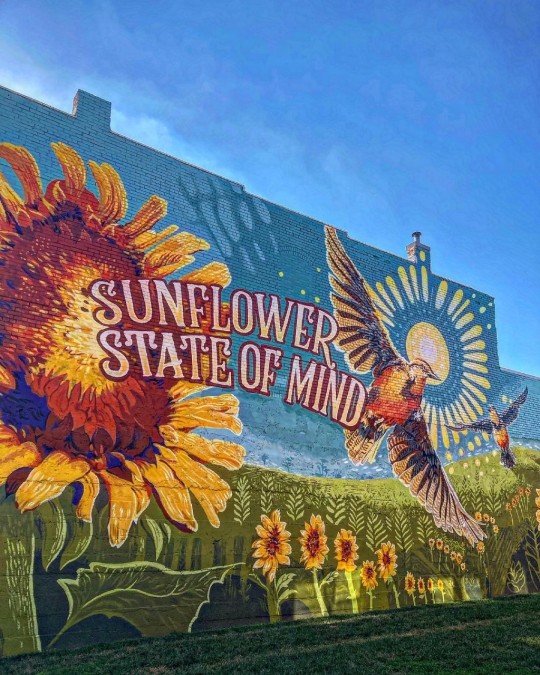




0 notes
Photo




New Missile Silo just dropped! $380,000 in Abilene, KS. 0 bd, 1 ba. 6,900 sf. And, it has the sought-after standard silo layout. It’s the latest defunct missile silo to be listed on property sites, and was initially offered for $420,000 in March 2020 — fittingly in hindsight — just as the Covid-19 pandemic began sweeping the globe.

Come on, down.

It’s got electricity and a little moisture problem. “It’s not for the faint of heart,” said listing agent John Dautel of Hirsch Real Estate in Abilene, Kansas. “It’s going to take a lot of work, but it’s no different from owning a home.”

Very sturdy and secure doors- look at the size of that door stop. The photos showcase a facility less conducive to comfortable living and more suited for intense protection — concrete blocks and rusted metal lining tunnels filled with exposed pipes and metal doors.

To the control room.

Oh, look, they left a Shop Vac.


Beautiful industrial look. I wonder if you can get a discount on massive quantities of Rust-O-Leum.

This is different. The Kansas property was designed to hold the Atlas F missile- it had a 4.5 megaton warhead and stood 82-feet tall. It could be launched in about ten minutes. There were 72 of the missiles throughout the country.

Lots of drama. This is where the missile was housed. Looking up to the opening, it’s about 85 ft. tall from the bottom.

It would make a great conversation piece if it was still in there.

In another, a former Chicago social worker turned an abandoned missile silo into a posh bachelor pad in Texas.

At least there’s a toilet and a shower.


Nice big driveway, secure gate and outbuildings. So far, there’s been some interest for the complex — set in an 11 acre property.


The Quonset hut is pretty big and has lots of potential.


And, there’s a former business on the property, too. Live and work on the property. The nearby town of Abilene has a population of about 6,000 and is known as President Dwight D. Eisenhower’s boyhood home. It’s now the site of his presidential library and the Greyhound Hall of Fame, designed to honor famous racing dogs.

Aerial view of the property.
https://www.zillow.com/homedetails/2432-Fair-Rd-Abilene-KS-67410/113177058_zpid/
121 notes
·
View notes
Photo

The Resolute desk, also known as the Hayes desk, is a nineteenth-century partners' desk used by several presidents of the United States in the White House Oval Office as the Oval Office desk. It was a gift from Queen Victoria to President Rutherford B. Hayes in 1880 and was built from the oak timbers of the British Arctic exploration ship HMS Resolute. The 1,300-pound (590-kilogram) desk was created by William Evenden, a skilled joiner at Chatham Dockyard in Kent, probably from a design by Morant, Boyd, & Blanford. The desk has been modified twice. Franklin Roosevelt requested the addition of a door with the presidential seal to conceal his leg braces and a safe but it was not installed until 1945, after his death. A two-inch tall plinth was added to the desk in 1961 and replaced in 1986.
HMS Resolute was abandoned in Melville Sound in 1854 while searching for Sir John Franklin and his lost expedition. It was found in 1855 floating in Davis Strait by George Henry, an American whaling ship. The Resolute was repaired and returned to England as a gesture of goodwill from the United States. After serving in the British Navy for a further 23 years as a supply vessel, the ship was decommissioned in 1879 and subsequently broken up in Chatham Dockyard in Chatham, England. A competition was held to design and build a piece of furniture that Queen Victoria could gift to the American president, built from the timbers of Resolute. Morant, Boyd, & Blanford won this contest and this desk was constructed shortly after.
The Resolute desk was moved to the second floor of the White House shortly after it was received on November 23, 1880. It stayed in the President's Office and Presidents Study on the east side of the second floor until the White House Reconstruction from 1948 to 1952. After the reconstruction it was placed in the Broadcast Room where Dwight D. Eisenhower used it during both radio and television broadcasts. Jackie Kennedy rediscovered the desk languishing under electrical equipment and had it brought to the Oval Office in 1961. The desk was removed from the White House after the assassination of President John F. Kennedy, when President Lyndon Johnson allowed it to be taken on a traveling exhibition with artifacts of the Kennedy Presidential Library. It was then put on display in the Smithsonian Institution. President Jimmy Carter brought the desk back to the Oval Office in 1977, where it has remained since, save that George H. W. Bush used the C&O desk in the Oval Office but kept the Resolute desk in the White House.
Two other furniture pieces were created from the timbers of the Resolute. The widow of Henry Grinnell, a wealthy philanthropist who spent large sums of money trying to find Sir John Franklin and his ships, received a desk now known as the Grinnell Desk. Queen Victoria also had a table made from the Resolute's timbers for herself to be used on her steam powered yacht, HMY Victoria and Albert. The first replica of the Resolute desk was commissioned in 1978 for a permanent display at the John F. Kennedy Presidential Library in Boston, Massachusetts, and since then five other presidential libraries and countless other museums, libraries, tourist attractions, and private homes and offices have acquired copies of the desk.
H.M.S. 'Resolute', forming part of the expedition sent in search of Sir John Franklin in 1852, was abandoned in Latitude 74º 41' N. Longitude 101º 22' W. on 15th May 1854. She was discovered and extricated in September 1855, in Latitude 67º N. by Captain Buddington of the United States Whaler 'George Henry'. The ship was purchased, fitted out and sent to England, as a gift to Her Majesty Queen Victoria by the President and People of the United States, as a token of goodwill & friendship. This table was made from her timbers when she was broken up, and is presented by the Queen of Great Britain & Ireland, to the President of the United States, as a memorial of the courtesy and loving kindness which dictated the offer of the gift of the 'Resolute'.
– brass plaque affixed to the desk
Daily inspiration. Discover more photos at http://justforbooks.tumblr.com
21 notes
·
View notes
Photo

📸 First page of letter from Harold Porter, 1945, National Archives, Dwight D. Eisenhower Presidential Library and Museum. Full letter online here.
Display Marks 75th Anniversary of Auschwitz Liberation
By the end of World War II, the Holocaust had claimed the lives of over 6 million Jewish people—nearly two out of every three in Europe.
On January 27, 1945, Soviet forces liberated the Auschwitz concentration camp complex in German-occupied Poland. Russian soldiers discovered thousands of sick, dying, and dead prisoners when they entered the complex of concentration camps, forced labor camps, and a killing center abandoned by the Nazis.
The full scope of Nazi atrocities grew clearer with every concentration camp liberated and mass grave discovered by Allied forces as they advanced across Europe in the final months of World War II.
Army medic Harold Porter penned this graphic description of the horrific scene at the newly liberated Dachau concentration camp on the former camp commandant’s stationery. Grappling with a grisly reality that he knew defied belief, Porter’s letter home acknowledged that “it is easy to read about atrocities, but they must be seen before they can be believed.”
This letter is currently on display at the National Archives Museum in Washington, DC, through February 5, 2020.
127 notes
·
View notes
Video
youtube
Presidential Primaries: What You Need to Know
Every four years, our country holds a general election to decide who will be our next president. Before that happens, though, each party must choose its candidate through primary elections.
But our system of primaries can be a bit confusing. So here’s a quick primer on the upcoming primaries, containing the most important things you need to know based on the most frequently asked questions:
Are primaries, caucuses, and conventions written into the Constitution?
No. The Constitution says nothing about primaries or caucuses. Or about political parties.
So where did primaries and caucuses come from?
From the parties themselves. The first major political party convention was held in 1831 by the National Republican Party (also known as the Anti-Jacksonian Party). The first Democratic National Convention was held in 1832.
Who decides how primaries are run?
It’s all up to the parties at the state level. Political parties can even decide not to hold a primary. This year, five states have decided not to hold Republican presidential primaries and caucuses, a move designed to stop Donald Trump’s long-shot primary challengers.
Can state laws override party decisions?
No. In 1981, the Supreme Court held that the Democratic Party wasn’t required to admit Wisconsin delegates to its national convention since they hadn’t been selected in accordance with Democratic Party rules. The court said that a political party is protected by the First Amendment to come up with its own rules.
Why did we start holding primaries?
In the 19th century, the process for deciding on a party’s nominee was controlled by party bosses, who chose the delegates to the party conventions.
In the early 20th century, some states began to hold primaries to choose delegates for party nominating conventions.
Although the outcomes of those primaries weren’t binding, they sent a message about how a candidate might do in a general election. In 1960, for example, John F. Kennedy’s victory in the West Virginia primary [archival footage] was viewed by Democratic Party leaders as a strong sign that a Catholic like Kennedy could win the votes of Protestants.
As recently as 1968, a candidate could still become the Democratic nominee without participating in any primaries, as Hubert Humphrey did that year. But since then, both parties have changed their rules so their presidential nominees depend on the outcomes of primaries and caucuses. They made these changes to better ensure their candidates would succeed in the general election.
What’s the difference between a caucus and a primary?
States that hold primaries allow voters to cast secret ballots in support of candidates. States that hold caucuses rely instead on local in-person gatherings at a particular time and place -- maybe in a high school gym or a library -- where voters who turn up openly decide which candidates to support. Here are the states that will have Democratic primaries in 2020 and those that will have caucuses: Iowa, Nevada, Kansas, North Dakota, Wyoming, and Maine.
What’s the advantage of one over the other?
Primaries are the easiest way to vote. Caucuses are more difficult to participate in, so the people who turn out for them are usually the most enthusiastic and engaged voters. In caucuses for the 2008 and 2016 Democratic nominations, for example, Hillary Clinton lost to Barack Obama and then to Bernie Sanders. Fewer than 5 percent of pledged delegates will be awarded by caucuses in the upcoming Democratic primary, down from 14 percent in 2016.
Are Democratic and Republican primaries the same?
No. One of the biggest differences is in how delegates are allocated. In the Democratic Party delegates are allocated proportionally -- so that, for example, a candidate who wins 40 percent of a state’s vote in the Democratic primary will win 40 percent of that state’s delegates. The Republican Party allows each individual state to choose how its delegates are allocated, with some states allocating delegates proportionally and some giving all their delegates to the winner of the primary.
Another difference involves what are known as “superdelegates” -- typically elected officials and prominent party members like former presidents or congressional leaders. These superdelegates are automatically seated at the party’s national convention and can vote however they like. Superdelegates are still used by the Democratic Party but the Republican Party eliminated superdelegates in 2012. In 2018, the Democratic Party reduced the power of superdelegates, allowing them to vote only in contested conventions, when no candidate has a majority of votes going into the convention.
What’s the difference between an open, semi-closed, and closed primary?
Some states have closed primaries, where the only people who can participate are those that have registered as members of a political party. Independents and members of another party are not eligible.
Other states have semi-closed primaries, in which both registered party members and Independents can vote. Different states also have different rules about when voters must choose which primary they wish to vote in -- for example, registering with a party on the day of the primary or even at the time of voting.
In open-primary states, any registered voter can participate in which ever party’s primary they choose.
Why is Iowa first? Why is New Hampshire second? How is that order determined?
It may seem odd that the first two primaries occur in tiny overwhelmingly white rural states -- and it is. But hey, here we are. Iowa’s caucus is first, by tradition. New Hampshire’s primary must occur at least seven days before any other primary, according to New Hampshire state law. Originally held in March of a presidential election year, the New Hampshire primary has repeatedly been moved forward in order to maintain its status as the first primary.
What’s “Super Tuesday?”
That’s the Tuesday during primary season when the greatest number of states hold primary elections. This year, Super Tuesday will be March 3 -- coming after the Iowa caucus, the New Hampshire primary, the Nevada Democratic caucus, and the South Carolina Democratic primary. And Super Tuesday will be really super because two huge states with lots of delegates -- California and Texas -- have both moved their primaries to March 3. All told, 9 states will hold primaries that day, including 6 of the most-populous -- meaning almost 29 percent of the U.S. population will have a chance to get in on picking the presidential candidates that day.
So once a state’s voters have decided on their candidates, how are the specific delegates to a party convention chosen?
The national parties have left that up to their state parties, so it varies from state to state. Delegates are typically party activists or insiders who have been supporters of the candidate they’re chosen to represent at the national party convention.
Do delegates to a national party convention have to vote for the candidate they've pledged to support?
Both parties’ rules require that they do, at least on the first ballot.
What’s a contested convention?
A contested convention is one where no candidate has a majority of delegates going into the convention.
When was the last contested convention?
A while back, but we could see one again this year. In 1984, Vice President Walter Mondale entered the Democratic convention only a few delegates short of a majority. In 1976 Gerald Ford and Ronald Reagan competed for the Republican nomination, and at the start of the convention neither had a majority.
What’s a brokered convention?
A brokered convention occurs when, after the first round of voting, still no candidate has a majority of delegates. If that happens, delegates are then free to vote for whomever they want.
When was the last brokered convention?
You have to go all the way back to 1952 to find a brokered convention. That year both conventions were brokered. Adlai Stevenson finally emerged as the Democratic nominee and Dwight Eisenhower, the Republican. But here again, it might happen in 2020.
Which party’s convention comes first? And when and where?
By tradition, the party that holds the White House holds its nominating convention after the party that seeks the White House. So this year, the Democratic National Convention will be July 13 through 16 in Milwaukee. The Republican National Convention will be August 24 to August 27, in Charlotte.
Are vice presidential candidates chosen or announced at the convention?
Not necessarily. Presidential nominees often announce their choice of running mates in the days or weeks leading up to the nominating conventions.
So what do we do?
Make sure you’re registered and be sure to vote -- in your state primaries or caucuses, and in the general election November 3!
110 notes
·
View notes
Text
vimeo
Here's the phone call between Lady Bird Johnson and LBJ from March 7, 1964 where Lady Bird is reviewing President Johnson's performance at a televised press conference, showing a very different side of both Lady Bird and LBJ, as mentioned in my last post.
This is from the LBJ Library's awesome LBJ Tapes website, created in conjunction with the University of Virginia's Miller Center, which specializes in Presidential history. The LBJ Tapes website features an archive of audio and transcripts of LBJ's taped phone calls that you can search or browse through depending on details such as the topic of conversation, date of the phone call, or names of the participants of the calls (which include people like Lady Bird, Martin Luther King Jr., Jacqueline Kennedy, Gerald Ford, Robert F. Kennedy, Ted Kennedy, Dwight D. Eisenhower, Harry S. Truman, Richard Nixon, Hubert Humphrey, and scores of other important historical figures).
You can really spend days exploring the LBJ Tapes website, and some of the more fascinating topics like LBJ's calls in the hours and days following JFK's assassination where he's becoming more comfortable in the Presidency and begins asking (and, in some cases, ordering) people to serve on the Warren Commission, or LBJ's behind-the-scenes machinations during the 1968 Presidential campaign, as MLK and then RFK are assassinated, the 1968 Chicago Democratic Convention spins out of control and Richard Nixon's campaign makes some shady moves with the Vietnamese to help ensure their own victory. On all of these calls, you hear the real Lyndon B. Johnson and they give an eye-opening definition to the "Johnson Treatment".
#LBJ Tapes#History#Politics#Presidents#Presidential Politics#Presidential History#Lyndon B. Johnson#Lyndon Johnson#President Johnson#LBJ#LBJ Library#White House Tapes#Lady Bird Johnson#Miller Center#University of Virginia#Political History#Presidential Elections#1968 Election#1968 Democratic National Convention#Chicago Seven#JFK Assassination#Kennedy Assassination#Warre Commission#Richard Nixon#Martin Luther King Jr.#MLK#Robert F. Kennedy#RFK#Johnson Treatment#Gerald Ford
8 notes
·
View notes